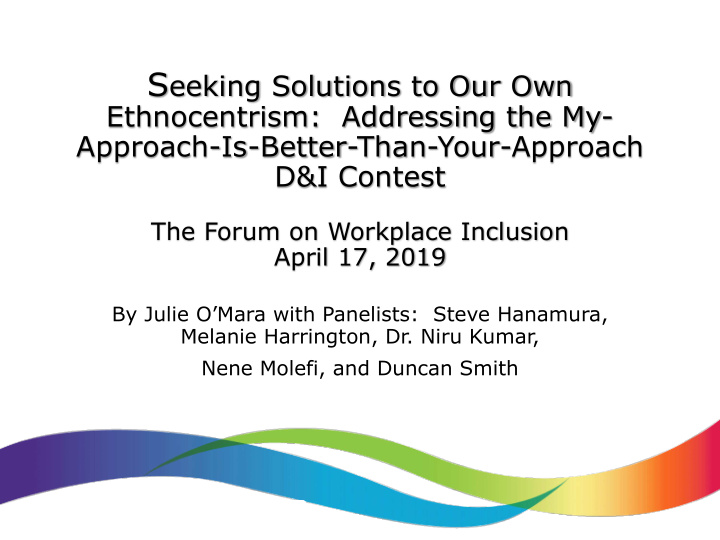



S eeking Solutions to Our Own Ethnocentrism: Addressing the My- Approach-Is-Better-Than-Your-Approach D&I Contest The Forum on Workplace Inclusion April 17, 2019 By Julie O’Mara with Panelists: Steve Hanamura, Melanie Harrington, Dr. Niru Kumar, Nene Molefi, and Duncan Smith
Learning Outcomes • Explore and reflect on ethnocentrism and how it negatively impacts our own behavior and the D&I profession. • Develop actions to support and collaborate with all D&I approaches; dig deep to eliminate the conflicts among approaches. • Apply this learning to other silos and ethnocentric behaviors in your organization.
Agenda • Learning Outcomes and Agenda • Coffee Shop Drama • A few words about Ethnocentrism • Approach Group Discussions and Reports • Actions to Eliminate Conflicts Among Approaches and Promote Collaboration
Panelist Steve Hanamura Acting in the role of THE DIGNITY APPROACH
Panelist Melanie Harrington Acting in the role of THE COMPLIANCE APPROACH
Panelist Dr. Niru Kumar Acting in the role of THE SOCIAL JUSTICE APPROACH
Panelist Nene Molefi Acting in the role of THE ORGANIZATION DEVELOPMENT APPROACH
Panelist Duncan Smith Acting in the role of THE COMPETENCE APPROACH
ETHNOCENTRISM “Thinking one’s own ways are superior to others”
Competence Improving Skill, Knowledge, and Ability Compliance Social Justice Complying with Laws Treating People Equitably and Regulations and Ethically Dignity Organization Development Affirming the Value and Interconnectedness of Every Person Improving Organizational Performance Approaches to Diversity & Inclusion
COMPETENCE: IMPROVING SKILLS, Competence KNOWLEDGE, AND ABILITY Improving Skill, Knowledge, and Ability This approach focuses on increasing the competence of individuals and organizations to interact effectively in the context of many similarities and differences. Measures of success align with demonstrated competence. Terms sometimes used when describing this approach: • Awareness • D&I skills training • Bias reduction • Intercultural communications (conscious and unconscious) • Multicultural education • Cultural competence
COMPLIANCE: COMPLYING WITH Compliance LAWS AND REGULATIONS Complying with Laws and Regulations Most organizational and societal entities have laws, rules, codes, guidelines, norms, and the like that indicate how people within and sometimes outside of those entities are expected and/or required to behave. Terms sometimes used when describing this approach: • Affirmative action • Human Rights • Employment equity • Regulatory • Equal Opportunity • Representation/targets/quotas
DIGNITY: AFFIRMING THE VALUE Dignity AND INTERCONNECTEDNESS OF Affirming the Value and Interconnectedness of Every Person EVERY PERSON This section includes secular and religious perspectives that recognize the value and worth of every human being and our interdependence. Terms sometimes used when describing this approach: • Cultural humility • Spirituality • Mindfulness • Unity • Right thing to do • Values
ORGANIZATIONAL Organizational Development DEVELOPMENT: IMPROVING Improving Organizational Performance ORGANIZATIONAL PERFORMANCE This approach is distinguished by the weighting of performance goals in determining which actions to take to optimize personal and organizational performance. Terms sometimes used when describing this approach: • Business imperative • Leveraging diversity/differences • Change management • Systems change • Culture change • Transformation
SOCIAL JUSTICE: TREATING Social Justice PEOPLE EQUITABLY AND Treating People Equitability and Ethically ETHICALLY This approach is aimed at achieving justice and fairness, ultimately for everyone. Terms sometimes used when describing this approach: • Equity • Restorative justice • Human rights • Social justice • Overcoming/dismantling • Social responsibility oppression
Group Activity Instructions 1. What are the assets of that approach? 2. What are the potential liabilities of that approach? 3. What will it take to better collaborate with the other approaches?
Group Reports 1. What are the assets of that approach? 2. What are the potential liabilities of that approach?
Group Reports 3. What will it take to better collaborate with the other approaches?
Thank you to our actors … please do not type cast them to the role they played … here are their real jobs and contact information. All are versatile in their approach to D&I Work. Steve Hanamura • Hanamura Consulting, Inc. • Beaverton, Oregon USA • hanamuras@integrity.com • + 503-297-8658 Melanie Harrington • Vibrant Pittsburgh • Pittsburgh, Pennsylvania USA • melanie@vibrantpittsburgh.org • + 412-281-8600 Dr. Niru Kumar • Ask Insights • New Delhi, INDIA • drnirukumar123@gmail.com • + 91 98 718 21425 Nene Molefi • Mandate Molefi • Johannesburg, South Africa • nene@mandatemolefi.co.sa • + 27 11 728 9585 Duncan Smith • ADC Associates • Melbourne, AUSTRALIA • dsmith@adc- assoc.com • + 61-419-329-539 Patron: Julie O’Mara • The Centre for Global Inclusion • North Las Vegas, Nevada USA • Julie.omara@centreforglobalinclusion.org. • + 702-335-9959
For Notes following the discussion, go to www.centreforglobalinclusion.org and navigate to News
Use and Permissions Global Diversity and Inclusion Benchmarks (GDIB) is distributed as a PDF document. Permission to use this tool will be granted at no cost by signing an agreement with the authors. To download the GDIB, for the Permissions Agreement, and additional tools and resources, go to: www.centreforglobalinclusion.org Co-authors: Julie O’Mara Alan Richter + 1-702-541-8920 + 1-212-724-2833 julie@entreforglobalinclusion.org alanrichter@centreforglobalinclusion.org
Recommend
More recommend